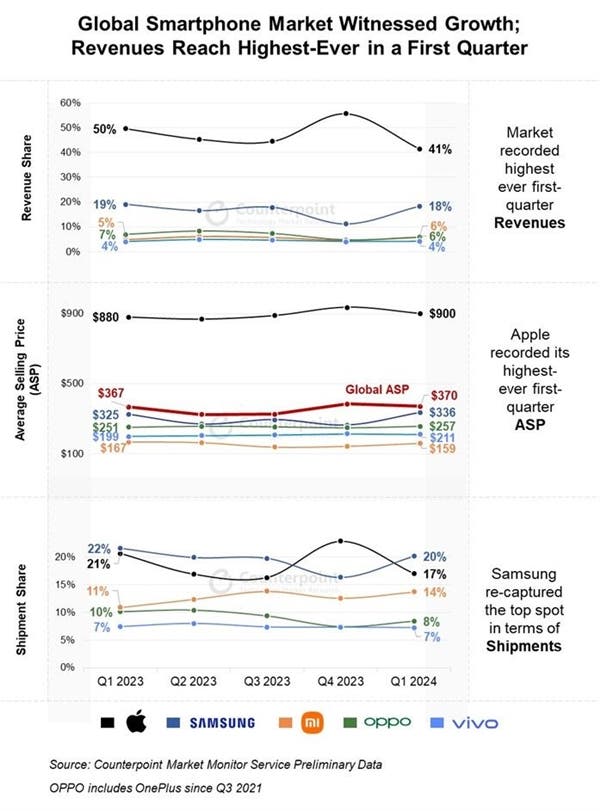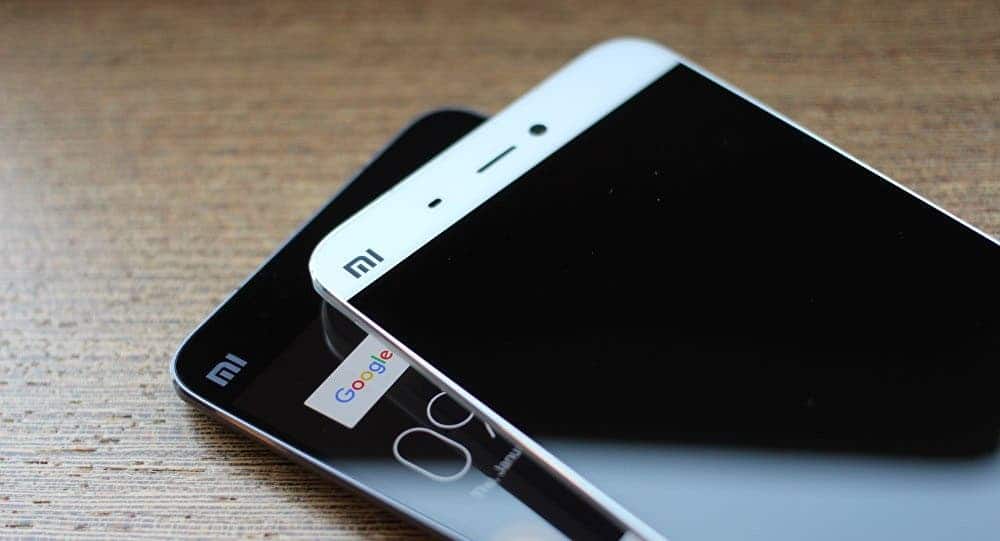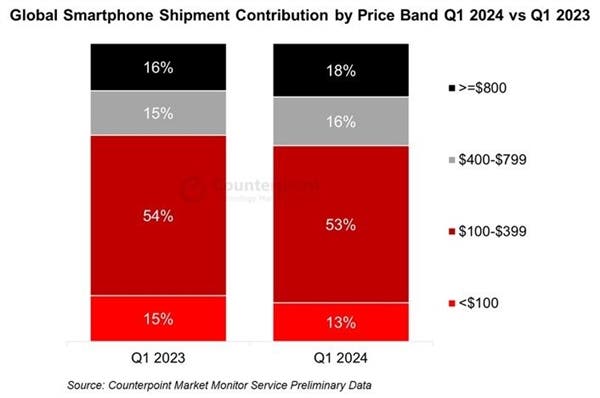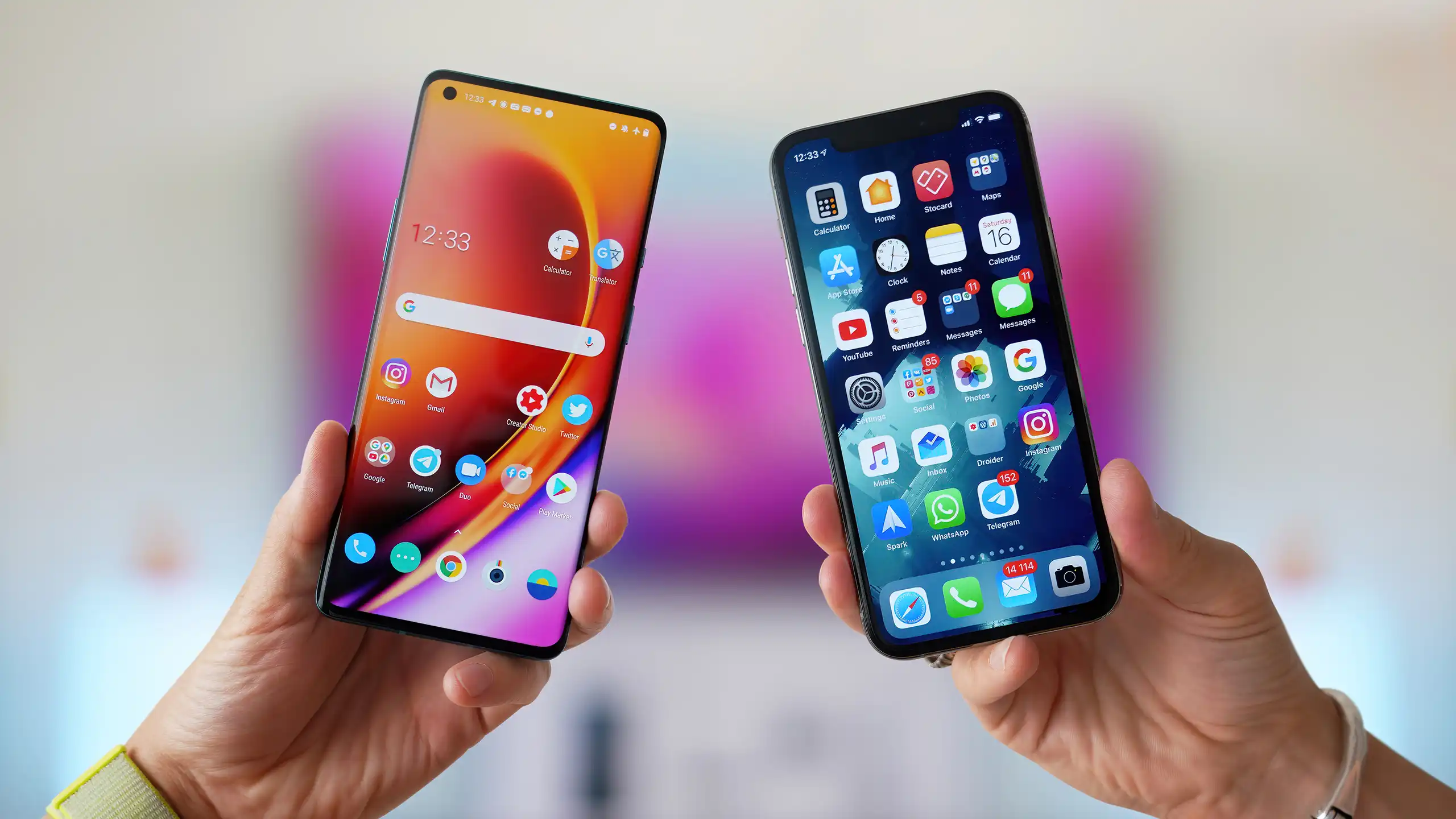According to the latest report from Counterpoint Research, the global smartphone market saw a healthy 6% year-on-year increase in shipments during the first quarter of 2024, reaching 296.9 million units. This marks the third consecutive quarter of growth, indicating a strong recovery for the industry. As expected, the major smartphone brands put up a good performance.

Samsung shoots back to No. 1 spot
Leading the pack is Samsung, which has regained its position as the world’s number-one smartphone brand. The South Korean tech giant captured a 20% market share, shipping 59.4 million units in Q1 2024. This represents a solid performance, especially considering the high inventory backlogs that plagued the previous quarter.
After being pushed down to second place by Apple in the previous quarter, Samsung surged ahead with impressive sales figures, particularly driven by the successful launch of the Galaxy S24 series. The Galaxy S24 series, which introduced innovative AI features and received positive reviews in the North American market, played a pivotal role in Samsung’s resurgence. The company’s strategic focus on premium phones, which are more profitable, has paid off, with Samsung planning to further dominate the premium phone market by leveraging a lawsuit filed by the U.S. Department of Justice against Apple for alleged antitrust violations.

Samsung’s market share in Europe and the United States saw significant growth, with the Galaxy S24 series being a key driver of this success. The company’s performance in the premium phone segment, coupled with the positive response to its foldable phones, has solidified its position as the top smartphone brand globally. Samsung’s ability to adapt its strategies, launch innovative products, and capitalize on market opportunities has propelled it back to the coveted number-one spot, showcasing its resilience and competitiveness in the dynamic smartphone industry.
Apple lost the top spot – settling for No. 2
In contrast, Apple, the previous market leader, saw its shipments decline by 13% year-on-year, falling to second place with a 17% market share. The tech giant shipped 50.5 million iPhones during the quarter, a significant drop compared to the same period last year. The primary factor contributing to Apple’s performance woes was the high inventory backlogs that had plagued the company in the previous quarter. This inventory buildup, coupled with a lack of major product launches, appears to have weighed heavily on Apple’s ability to maintain its momentum in the global smartphone market.

Xiaomi Leads the Android Camp with Impressive Growth – basks in the euphoria of N0. 3
While the top two spots were dominated by the industry’s heavyweights, the Android camp also saw some notable performances. Xiaomi, the Chinese smartphone maker, emerged as the fastest-growing brand among the top five, with a 34% year-on-year increase in shipments. The company shipped 41.5 million units, securing a 14% market share.
Oppo and Vivo claim No. 4 and No. 5 respectively
OPPO and vivo, two other Chinese brands, also maintained their positions in the top five, with market shares of 8% and 7%, respectively. In fourth position is OPPO with a shipment of 23.7 million units. Vivo takes the fifth spot with 20.8 million in shipments.
Apple Dominates in Profitability, but Android Brands Catch Up on Pricing
Despite the Android camp’s gains in market share, Apple continues to dominate the industry in terms of profitability. The report indicates that the iPhone maker earns a staggering 90% of the industry’s profits, thanks to its ability to command premium pricing.

The average selling price (ASP) of an iPhone in the first quarter of 2024 was $900 (approximately ¥6,517), significantly higher than the competition. Samsung’s ASP was $336 (approximately ¥2,430), while OPPO, Xiaomi, and vivo had ASPs of $257 (approximately ¥1,860), $211 (approximately ¥1,530), and $159 (approximately ¥1,151), respectively.
However, the Android brands are slowly catching up on pricing, with the premium segment (above $800) growing the fastest and accounting for 18% of smartphone shipments in the first quarter, up from 16% in the same period last year. This suggests that consumers are increasingly willing to pay more for high-end Android devices, posing a challenge to Apple’s dominance in the premium market.
Emerging Markets Drive Growth, Europe Leads the Recovery
The report also highlights the role of emerging markets in driving the overall growth of the smartphone industry. These markets, particularly in Asia and Africa, continued to maintain strong momentum, contributing to the 6% year-on-year increase in global shipments.

Additionally, Europe, especially Central and Eastern Europe, experienced the fastest growth compared to the difficult period in the first quarter of 2023. This recovery in the European market is a positive sign for the industry, as it indicates a broader global rebound.
Smartphone Revenue Reaches All-Time High
The growth in smartphone shipments has also translated into a significant increase in industry revenue. In the first quarter of 2024, global smartphone revenue grew by 7% year-on-year, reaching an all-time high for the first quarter. This revenue growth can be attributed to the increasing demand for premium devices, as evidenced by the faster growth in the price segment above $800, which now accounts for 18% of total smartphone shipments.
Conclusion
The global smartphone market has shown a strong recovery in the first quarter of 2024, with Samsung reclaiming the top spot and Xiaomi leading the Android camp with impressive growth. While Apple continues to dominate in terms of profitability, the Android brands are making strides in the premium segment, posing a challenge to the iPhone maker’s dominance.
The growth in emerging markets and the recovery in Europe have also contributed to the overall industry’s performance, with global smartphone revenue reaching an all-time high for the first quarter. As the market continues to evolve, it will be interesting to see how the top players adapt their strategies to maintain their competitive edge in this dynamic landscape. What do you think about Samsung’s rebound? Let us know in the comment section below





